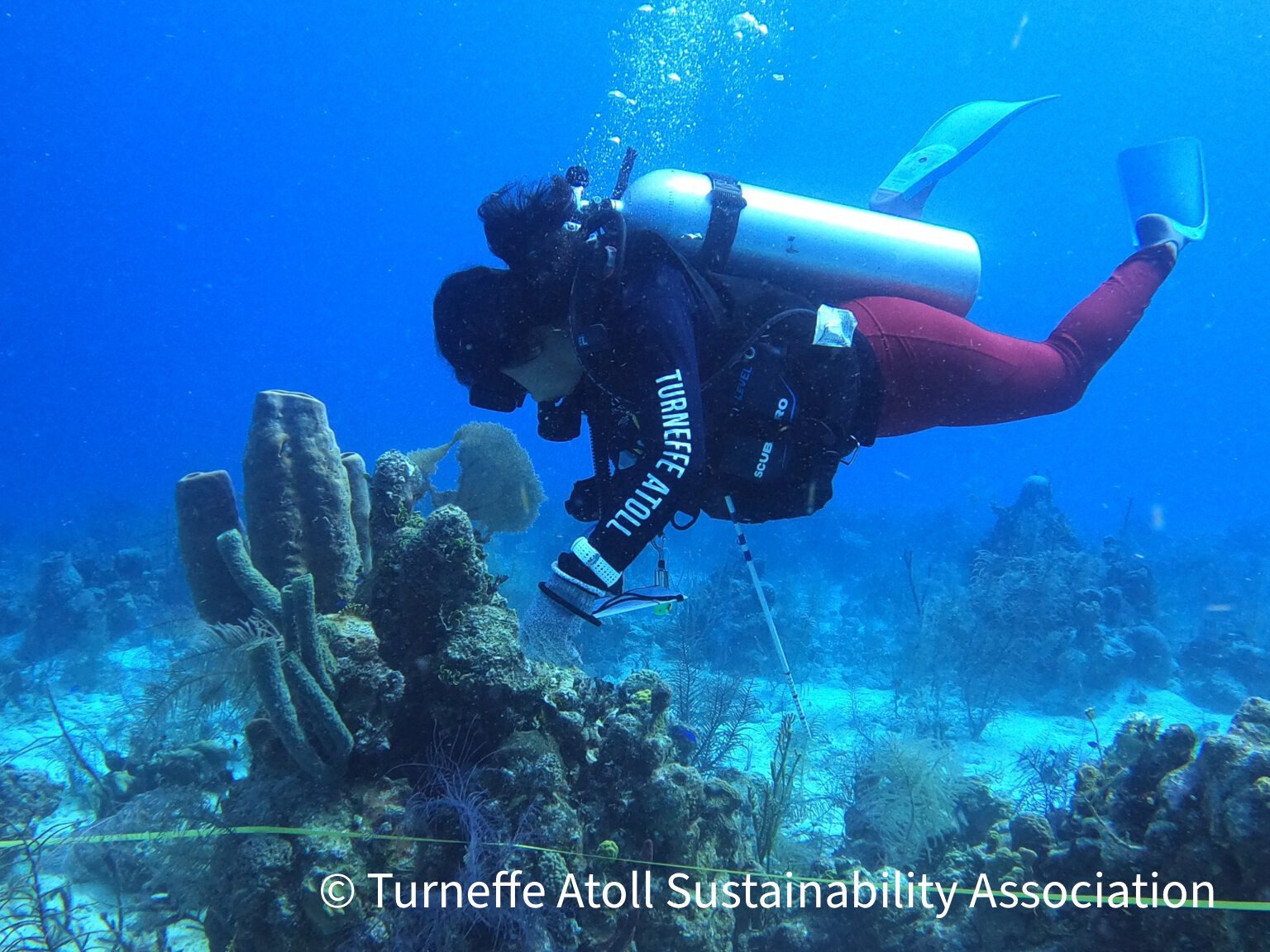Stretching thirty miles long and ten miles wide, the Turneffe Atoll Marine Reserve is the largest marine reserve in Belize. Within its network of flats, creeks and lagoons, a traditional fishery based on conch, finfish and lobster has thrived for generations providing food security for many Belizeans. This vast expanse encompasses a variety of habitats, including coral reefs, seagrass beds, and mangrove forests, creating an ideal environment for diverse marine life. With no fixed human settlements, this marine protected area (MPA) boasts a pristine, breathtaking scenery, offering a true paradise for divers, snorkellers, fisherfolk and nature lovers. The biodiversity of the Turneffe Atoll makes it a unique hotspot for sustainable fisheries management, marine conservation, sustainable ecotourism, and enabling coastal community livelihoods.
Now is the time to make the Turneffe Atoll Marine Reserve your ‘bucket list’ destination!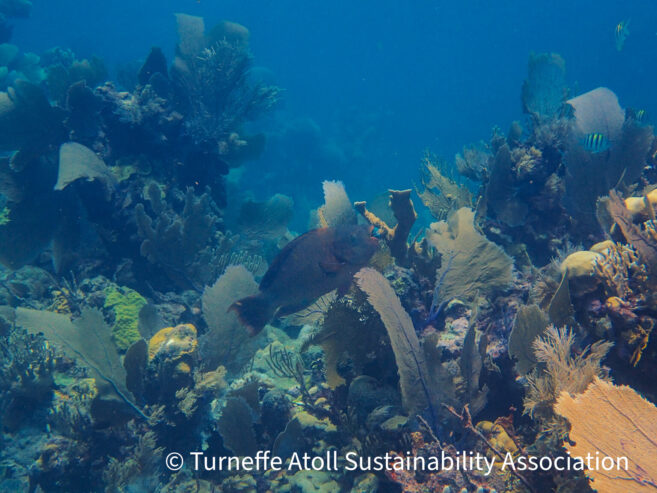
But protecting and managing this marine protected area is no easy feat, it is a huge task. Since 2013 the Turneffe Atoll Sustainability Association (TASA) has received its mandate as the official co-manager of the marine reserve from the Government of Belize through the Belize Fisheries Department. The award-winning nonprofit blends traditional engagement strategies and technology to redefine marine conservation and improve management effectiveness, which IUCN defines as ‘how well-protected areas are managed.’
Technological Solutions and Ocean Sustainability
On any given dawn on Turneffe Atoll, a digital alert spurs the conservation team to action. The Association has positioned its team of officers along the Atoll at command bases in Mauger Caye and Caye Bokel, with command control in Calabash Caye. Given the vastness of Turneffe, the patrols and enforcement response need to be strategic and targeted.
Meet Valdemar Andrade, TASA’s Executive Director. He sheds light on their radar system, a watchful eye that spans a 5 to 8-mile radius, silently scanning the horizon for vessels. “We can monitor 24 hours every day, picking up vessels with or without a transponder. It even has geofencing, allowing us to see if a vessel breaches the conservation zones.”
Imagine dawn breaking, a digital alert is sent to TASA’s conservation team, and the patrols are strategic and targeted. Valdemar shares, “By the first quarter of this year, we will integrate a drone with the radar to enhance surveillance. The drone will do an enforcement patrol, capturing registration details and assessing the need for a full-fledged patrol.” This strategic approach minimizes fuel costs and enhances efficiency – an opportunity for conservation and technological solutions to be revolutionary.
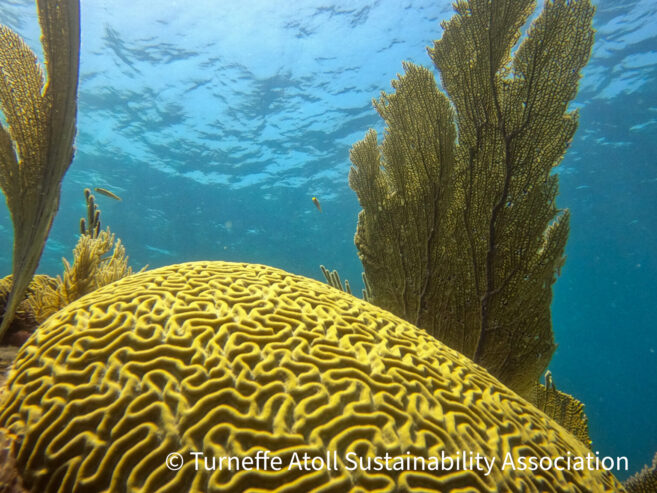
Sustained Financing through the Belize Fund
The BZD $831,788 grant received under the Grants Award Program (GAP) fuels the Turneffe Atoll Sustainability Association’s vision to strengthen park management and enforcement strategies by putting in place data-backed infrastructure, interventions and initiatives including scaling up digital applications, training officers to make better decisions through the technological solutions, and promoting greater awareness and engagement with these solutions among users and key community stakeholders of Turneffe.
Valdemar reflects, “This project has enabled us to continue to have consistent data through cutting edge technology using drones, the spatial monitoring and reporting tool (S.M.A.R.T.) – radar, and now hydrophones.” He continues, “Before technology, and before this level of support [from the Belize Fund], it was hard to keep consistency in gathering data over time.” Now, TASA is building a robust infrastructure that collects information on visitation trends, marketing insights, and sustainable tourism practices which contribute to efforts to achieve marine prosperity.
Achieving these goals require a delicate balance with engaging communities. The Belize Fund grant ensures that amidst this digital innovation, TASA’s team is not just enforcing regulations; they are crafting a discourse and new narrative for marine conservation that recognizes the technological needs and trends of the Turneffe Atoll stakeholders. Devon Gabourel, TASA’s Education and Outreach Coordinator, elaborates, “In our ongoing conversations, the older traditional fishers and the newer fishers want to see the use of GPS, apps, and WhatsApp. This grant is allowing us to embrace these technologies.”
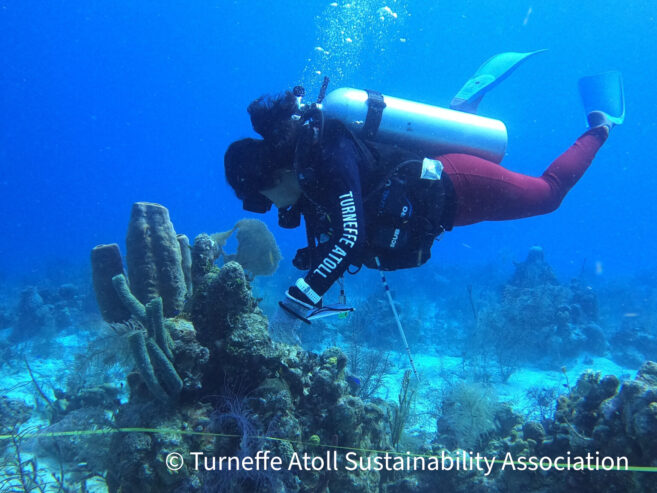
Resilient Blue Economy: Not a Buzzword, But a Lifeline
The spotlight shifts to the delicate balance between long-term sustainable financing and the country’s blue economy. Valdemar champions responsible tourism and shares that the Turneffe Atoll attracts hundreds of tourists annually for snorkelling, scuba diving, flyfishing, and other water-based and recreational activities including a nature trail and one of the newest wreck dives in the world, “The Wit”.
“We’ve moved to sustainable financing because, as a natural resource-based economy, it’s imperative. Turneffe has an annual value of an estimated $500 million. It’s not solely cash return but also, in shoreline protection, tourism, fisheries and blue carbon, and our budget is around $1.5 to $2 million annually. It’s an investment that reaps returns for our economy.”
This reality compels the Turneffe Atoll Sustainability Association to take a holistic approach to managing marine protected areas particularly as other threatened and endangered species depend on its thriving ecosystems such as the hawksbill and green turtles, manatees, American saltwater crocodiles and dolphins, and at the same time enabling sustainable livelihoods, especially for coastal communities.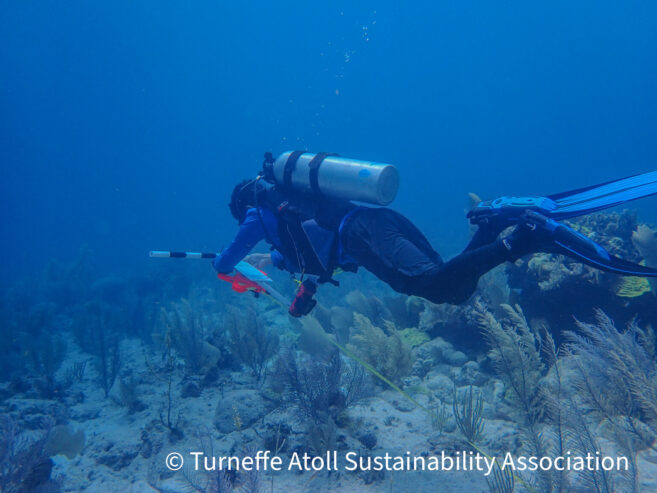
Navigating The Waters: Building Trust and Bridges
On Turneffe, there are approximately 33-36 fishing camps dispersed across the atoll. Skiff fishers from Belize City, primarily engaged in lobster and conch fisheries, with minimal involvement in finfish activities predominantly operate these encampments. Additionally, sailboat fishers from Chunox, Copper Bank, and, to a lesser extent, Sarteneja, contribute to the fishing activities in the area.
Now, consider the dynamic between TASA and the local fishing community. Just seven years ago, there were about 756 fishers who were licensed to fish on Turneffe Atoll. Today that number has almost doubled to 1300. Education and Community Outreach Coordinator Devon recalls that in his experience in his boat-to-boat interactions with the fishers, “Some view us as the owners of Turneffe, and it’s a challenge to convey that we are co-managers enforcing regulations set by the government after consultation with the fishing community.”
The challenge doesn’t dampen TASA’s spirits. Devon continues, “There’s a general acceptance of the work that we are doing. But there is also a legitimate expectation that we enforce the regulations and rules equitably and that there isn’t a system where some fishers have more rights than others.” Bridging this gap is crucial to building trust and fostering a shared responsibility for marine conservation.
Additionally, TASA endeavours to alleviate some of the pressure on traditional fisheries through the exploration of seaweed farming and king crab cultivation.
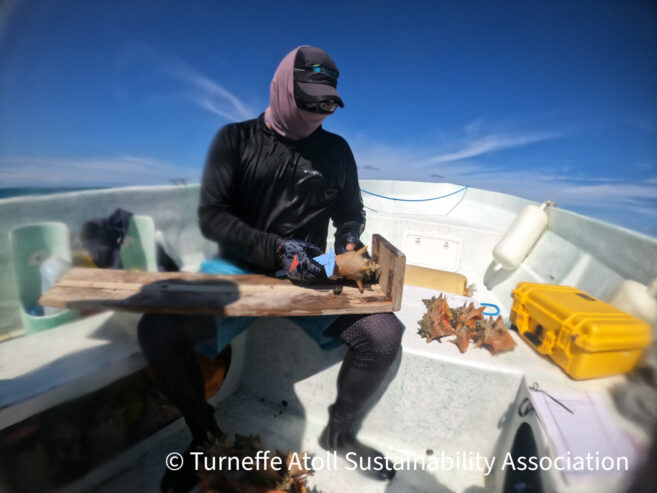
Conclusion: Sustained Financing for an Ocean-Positive Future
The Turneffe Atoll Sustainability Association’s work to develop and integrate technology solutions occurs within the Turneffe Atoll Marine Reserve but its impact promises benefits for Belize’s entire marine protected areas system and perhaps even for ocean conservation worldwide. This is a testament to the power of technology, innovation, and sustainable financing in the realm of marine conservation. The Belize Fund reaffirms its commitment to mobilize investments for the conservation and responsible development of Belize’s marine and coastal resources, supporting the country’s ocean-positive pathway.
By: Chalsey Gill Anthony, Communications Officer, Belize Fund for a Sustainable Future

